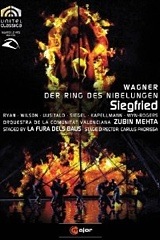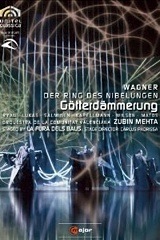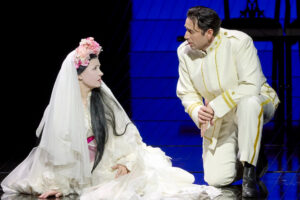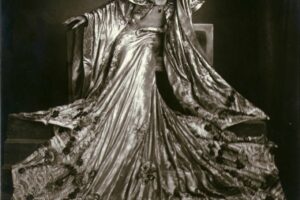

, the “Ring for the 21st Century” staged by La Fura dels Baus finally hits its stride. Gone is the “project everything you can think of on big screens and hope that something works” mentality that nearly spoiled the Rheingold and the first act of Walküre. The promise of the last two acts of Walküre, where the projections became subdued and the performances deeper, comes to fine fruition with this music drama.
Even Zubin Mehta and the Orquestra de la Comunitat Valenciana seem reinvigorated. The orchestra is fine throughout, particularly improved in the brass sections. Mehta leads with fine consistency and the wonderful third act is graced with subtlety and finesse.
The cast is uniformly excellent. This was my first hearing of tenor Lance Ryan in the title role, and he is quite impressive, though I think his characterization will deepen with time. Ryan has a more than serviceable sound, and manages the exhausting role without tiring or resorting to “barking.” He is particularly fine in the final act, both in his confrontation with The Wanderer and in the glorious awakening of Brünnhilde. Veteran Nibelungs Gerhard Siegel and Franz-Josef Kapellmann lend fine character singing; Catherine Wyn-Rogers gives an unusually nuanced and emotional Erda (though the costume police should have been called to do something about the conehead she had to sport).
Throughout this Ring I have been pleasantly surprised by Juha Uusitalo’s Wotan/Wanderer. His voice is powerful enough to sustain Wotan’s furies, yet he nicely modulates the tone and volume for the sensitive moments. His Wotan also has a sense of humor and a wistful weariness that suit the character well.
Jennifer Wilson, as in the Walküre, hits a home run with her Brünnhilde. The awakening scene is gloriously sung, with the artist bringing a womanly warmth to her potent soprano. She and Ryan partner very well, with a refreshing innocence in their characters that blooms with joy in the final duet.
The production’s projections are more realistic in several scenes (a magnificent ride through snow capped mountain peaks in the Prelude to Act III) and finally seem to illuminate the staging rather than distracting from it. The only major disappointment is the depiction of the dragon Fafner. A troupe of actors slithering with large needles on their backs is an interesting way of presenting the dragon’s claws, but the dragon itself was a 14-foot series of plain boxes, looking rather like the skeleton of a float for the Rose Parade.
Here the production team led by stage director Carlus Padrissa at last finds a balance between technology and performer, and the spectacular conflagration of visual and musical imagery that ends the Götterdämmerung is the finest achievement of all. The many elements — machinery, projections, a unique physical vocabulary by the company’s actors — come together completely. As one looks back on this Ring, the notion of maturation comes to mind, both for the characters and, indeed, for the production team. The productions all combine thrilling and fulfilling moments of visual imagery with odd digressions into childish obviousness; the good news is that the thrilling moments dominate the last three operas.
Mehta has the Orquestra de la Communitat Valenciana playing superbly in this music drama, and conducts with subtlety, nuance, romanticism, and sheer power when needed, reflected best in a playful and adventuresome “Rhine Journey.” The darker and more ominous aspects of the score are equally potent.
The majority of the cast are adequate-to-good. In the adequate range were Elisabete Matos, desperately channeling Norma Desmond as Gutrune; Ralf Lukas, an unusually wimpy Gunther, and Catherine Wyn-Rogers, who lacked the high notes for Waltraute. Lance Ryan was satisfactory as Siegfried, though he seemed to take a step backward from his stalwart turn in the previous opera, both vocally and histrionically. Franz-Josef Kapellmann made the most of his brief return as Alberich.
There were two titanic and definitive performances. First, the veteran Finnish bass Matti Salminen as Hagen, a role he seems to have in his voice and in his very bones. His hulking body and booming black bass sound made this the most frightening and dangerous Hagen of my experience, almost a sociopath in his obsession with power. And there is the remarkable Ms. Wilson as Brünnhilde, singing with clarion power in the top notes, and a singular warmth and beauty in the middle voice. She boasts a vast palette of vocal colors in her tone, and she gave us a multi-faceted character capable of passionate love, jealousy, fury, and sheer joy. Her expression as she rode her mechanical Grane into the flames was ecstatic. Based on this performance, I imagine that Wilson should be the Brünnhilde of choice — in fact, the Wagner soprano of choice — for many years to come.
This production, as did the other three parts of the Ring, has its quirky and peculiar moments. Some work well, like having Brünnhilde and Waltraute wrestling on the floor for control of the ring. Others are distracting and annoying, like the cartoonish way the Gibichungs are designed, with costumes and make-up covered with obvious dollar-and-euro imagery and dancing numbers projected behind them. It also seemed odd that Hagen pulls out a pistol at the end to shoot Gunther, when we’d only seen swords and spears before.
The entirety of this Ring seems to me a bold, inventive, and highly creative attempt at engaging a younger, digital-age audience in the glories of Wagner’s music and narrative. It is a tribute to this production that it succeeds most of the time, and even thrills some of the time. And while some of it drove me to distraction (see Rheingold and Act I Walküre), I’m very glad I stuck around.


























Comments